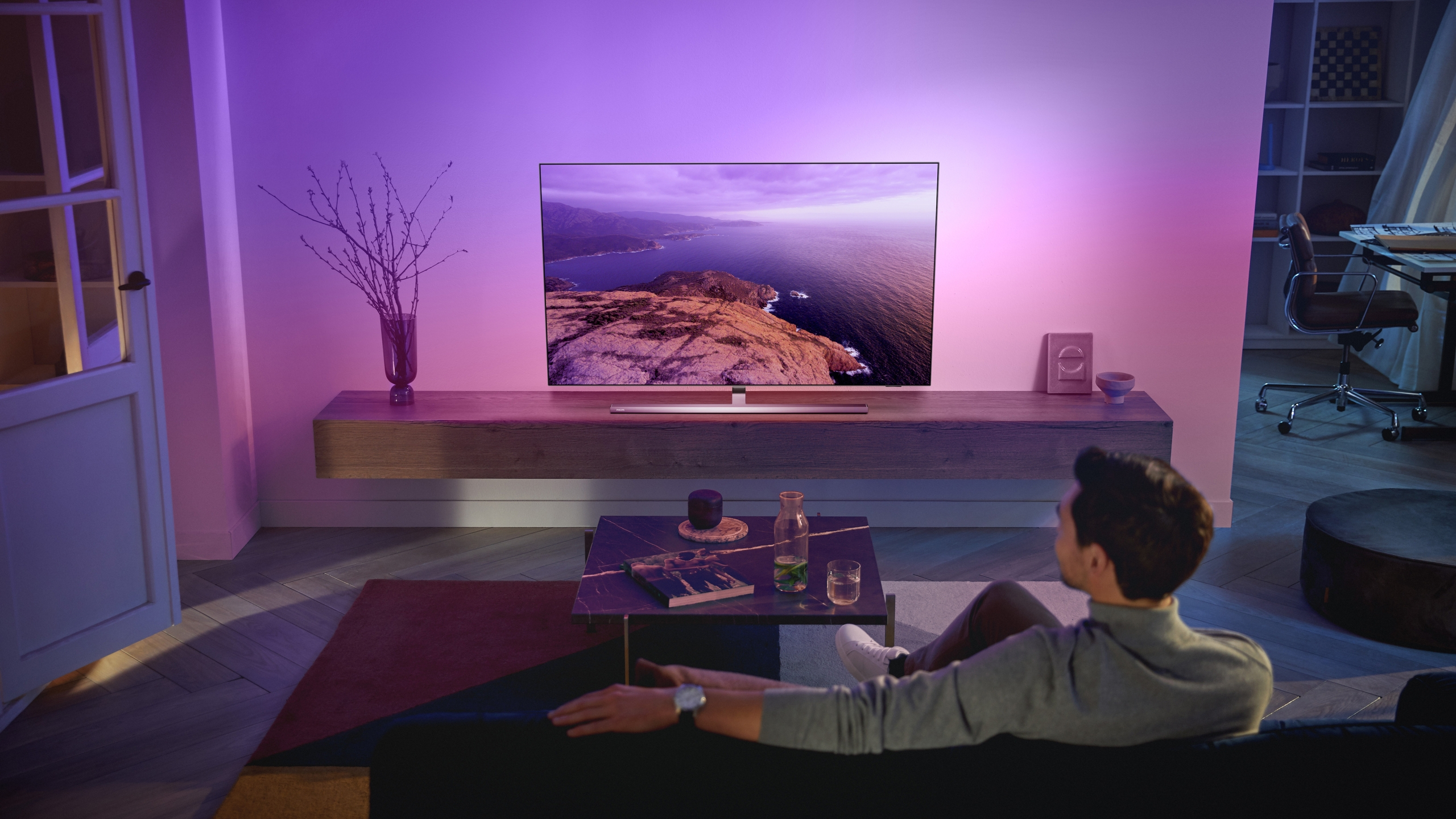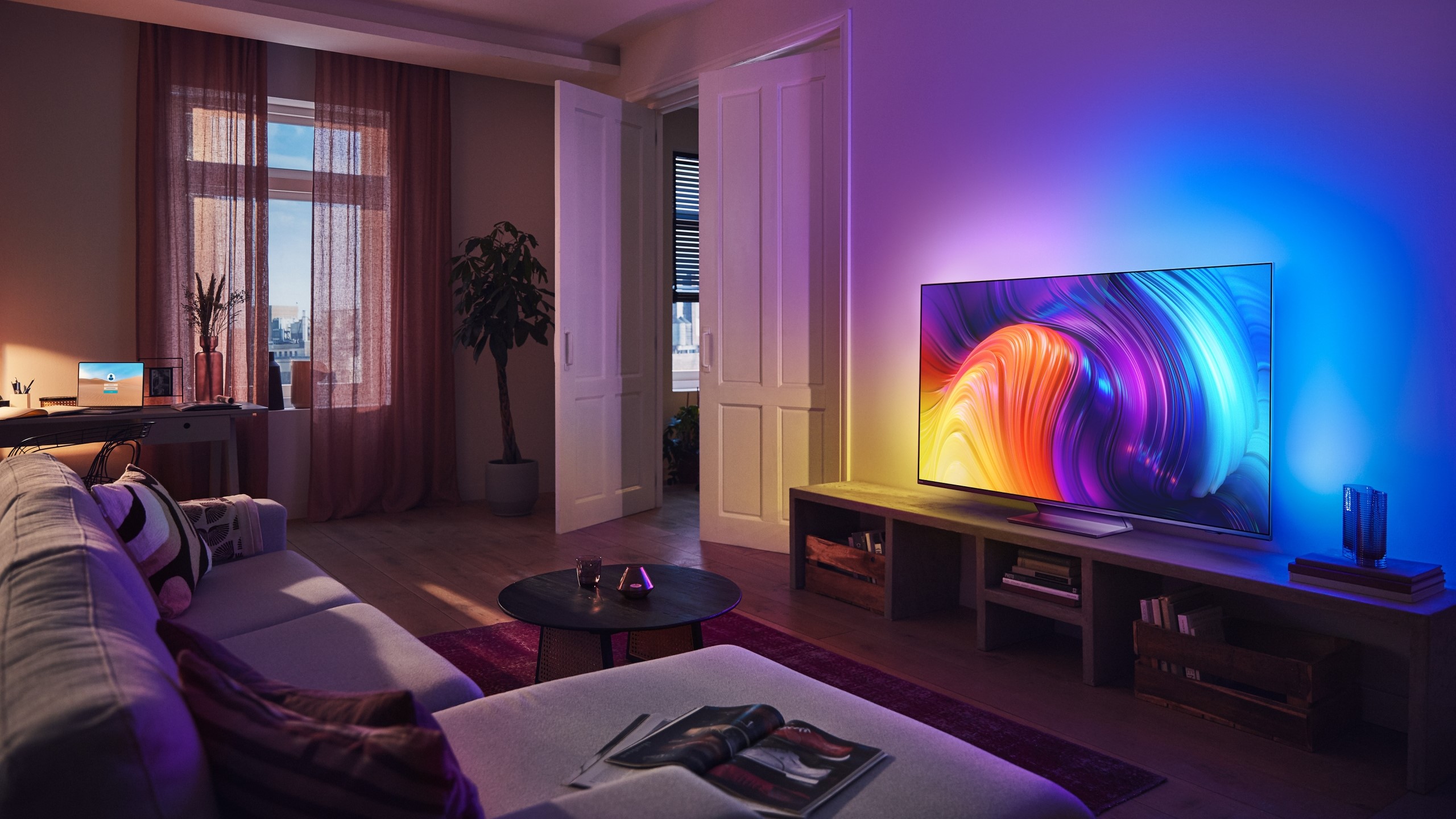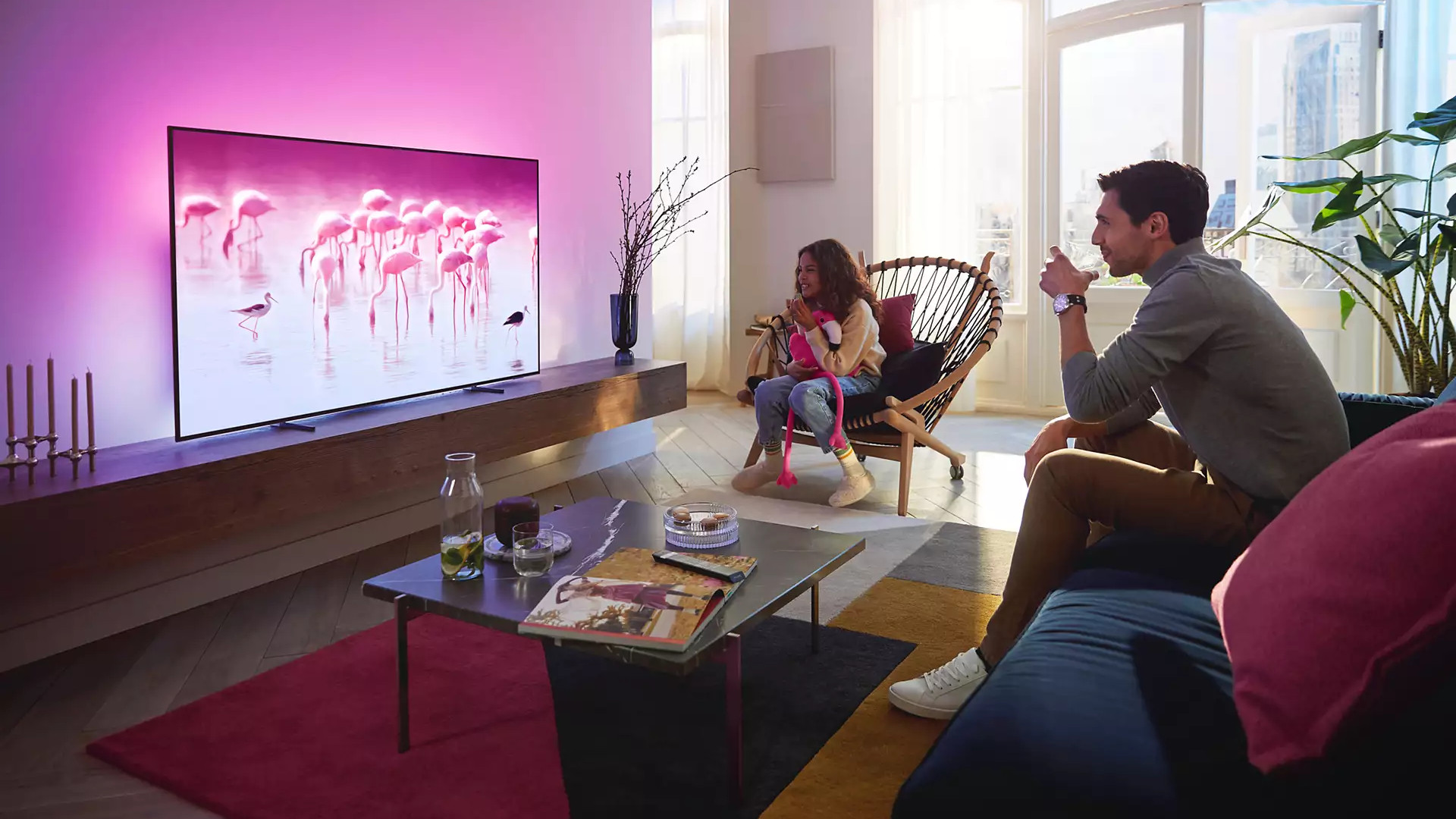Philips 2022 TV line-up: everything you need to know
All the biggest TV news from the TP Vision 2022 event

Philips has announced its new 2022 TV line-up, and there’s a lot to sink one’s teeth into. A wide range of TVs will be made available throughout the year, including flagship OLEDs and 4K Mini-LED TVs. It’s perhaps Philips’ busiest year yet when it comes to TVs, but it’s not a case of quantity over quality, as the brand has a few new tricks up its sleeve to separate it from the pack.
2022 marks the introduction of OLED EX technology (as first seen in LG displays), which is now being integrated into Philips’ new flagship OLED807 TV. We’ve got a whole section on OLED EX below, but in short, it’s an enhanced OLED display technology that’ll inject even more color and brightness into the picture. And on top of that, Philips is going all-in on gaming support, with 120Hz, HDMI 2.1, VRR and a ‘Game Bar’ menu option all on the way to the new sets.
It is worth noting that the range of new Philips TVs shown off during its TP Vision 2022 event are launching in the UK and Europe only, which is why you wouldn’t have seen them announced at CES 2022.
The 2022 Philips TVs you need to know about

Philips announced a wide range of new TVs for 2022 to suit varied budgets, but there are a few you absolutely must have on your radar as we progress through the year. Chief among the new tellies has to be the flagship Philips OLED807, launching sometime in the first half of the year, and featuring OLED EX technology that was first introduced by LG Display last year.
But the OLED807 isn’t the only TV in the limelight. The Philips MiniLED 9507 is poised to be a superb TV, featuring a 4K 120Hz refresh rate, 4 Ambilight sides for enhanced viewing immersion and HDMI 2.1 support that adds VRR (variable refresh rate) and a low latency mode that will likely make the MiniLED 9507 a superb choice for gaming.
Philips is also bringing back The One for 2022. The One 8807, to be precise, is once again positioning itself as a mid-range set that nonetheless packs in many desirable features, such as a 120Hz refresh rate, eARC and VRR support via HDMI 2.1 and a range of HDR formats including HDR10+, Dolby Vision and HLG.
Philips OLED807
Get daily insight, inspiration and deals in your inbox
Sign up for breaking news, reviews, opinion, top tech deals, and more.
Philips' top dog TV for the first half of 2022, the OLED807 looks to build upon the great foundations set by last year’s stellar OLED806 model.
Leading the picture quality charge is the newly-tweaked 6th-gen P5 AI picture processing engine, which will see a new suite of “intelligent” image preset options squeeze the most from the TV’s 4K OLED display. That panel is also making use of LG’s newer OLED EX technology – more on that in a bit, but it effectively results in a potentially 30% brighter image.
Viewers can choose settings based on Eye Care, Dark Detail Optimization or Colour Temperature Optimization considerations, while a new version of AI Auto Film Mode is added for a whopping total of seven movie-focussed image presets (including Filmmaker Mode) to tailor the screen to your liking. Ambient light sensing plays a more important role than previously too, with the set tweaking brightness and contrast detail based on ambient conditions for a more consistent tone, no matter the TV’s surroundings.
HDR formats once again include Dolby Vision, HLG, HDR10 and HDR10+ and HDR10+, but this time are joined by IMAX enhanced support, as seen increasingly found in premium Disney Plus streaming content.
As you’ll see across the mid-to-top tier of Philips TV range this year though, its gamers who are set to score the most from upgrading to a 2022 Philips television this year. The OLED807 features a silky-smooth 120Hz panel and HDMI 2.1 support. This unlocks VRR (variable refresh rate) support, auto low latency modes and the inclusion of AMD FreeSync and Nvidia G-Sync frame pacing tech, making for a stutter-free gaming experience even when frame rates outputted from a console or PC aren’t consistent. There’s also a new Game Bar menu overlay that gives instant access to the most handy TV settings that gamers may want to tweak as they play
Philips MiniLED 9507
The emerging MiniLED TV market offers some key advantages over regular LED TVs. Smaller and packed more tightly together, it allows many more thousands of micro LEDs to sit behind the LCD panel, and thus offer hundreds of discrete dimming zones.
This lets you get closer to the black levels of OLED without sacrificing brightness, while minimising the unsightly greying and washed out shadow detail that regular LED LCD TVs can suffer from.
That’s what’s on offer with the 4K Philips MiniLED 9507. Coming in 55”, 65” and 75” sizes, its feature set is otherwise identical to the OLED807. It offers four-sided Ambilight, all the major HDR formats (HDR10 / HLG / HDR 10+ / Dolby Vision / IMAX Enhanced), Android TV 11, and the same P5 AI picture engine and gaming features (HDMI 2.1, VRR, auto low latency) as the OLED807 flagship. It should be a good compromise between the best of what OLED and LED LCD has to offer.
Philips "The One" 8807
Philips’ ‘The One’ range, its attempt to demystify TV tech to deliver a mid-range set that anyone can walk into a shop and feel comfortable buying, makes a return for 2022 in the 8807 TV model. And it brings with it some interesting improvements.
Still an LCD display, it keeps Philips’ P5 picture processing engine, which should continue to offer strong color accuracy and handling of HD and SD sources on the 4K display, as well as smooth motion. But the bigger introductions are those designed for gamers. The TV now offers HDMI 2.1 with eARC support, and can handle 120Hz refresh rates, variable refresh rates (VRR) and can tap into the silky-smooth frame-pacing Freesync Premium tech from AMD, as seen on the newest Xbox consoles. Input lag hits a low 9ms, and a new ‘Game Bar’ on screen menu will let you tweak the most often called-for gaming settings on the fly.
HLG, Dolby Vision and HDR10+ compatibility is included, as is Dolby Atmos output support, with the TV coming in 43”, 50”, 55”, 65” and 75” screen sizes. There’s also a mammoth 86” model, the largest screen Philips has put out to date.
Note that there’s also a cheaper 60Hz model on the way too, so be sure to double check which model you’re after before laying down the cash – which does slightly undermine that ‘The One’ nomenclature.

What is OLED EX?
OLED EX is LG’s next-gen display technology, initially revealed just before the new year began, and now set to feature in Philips’ flagship OLED807 TV. That’s great news for those of you looking to buy the OLED807 this year, as OLED EX technology is set to enhance brightness by up to 30% over conventional OLED displays.
How does OLED EX achieve this? It does so through deuterium compounds, rather than hydrogen as usually found in OLED displays, which allow for the making of ultra-efficient LEDs that emit stronger light. It’s all a bit technical, and deuterium is actually fairly rare. Thankfully, LG seems to have found a way to extract the compound from water, making it readily available for use with OLED EX technology.
This new EX technology (shorthand for “Evolution” and “eXperience,” if you were curious) should add even more color to the display, and offer a greater distinction from the darkest blacks all the way to the richest of colors. In essence, then, it sounds like an improved version of already existing OLED technology.
And while OLED EX will perhaps be most noticeable on LG’s own 8K displays, it’s sure to be a selling point for Philips’ flagship OLED807, too, which also features four Ambilight sides that envelops the TV in immersive color profiles.
What gaming features are coming to Philips TVs in 2022?
Philips’ TVs are set to be some of its best yet for gamers looking to get the most out of their Xbox Series X, PS5, and PC gaming rigs.
Not only will you get HDMI 2.1 ports and a screen with a max refresh rate of 120Hz at 4K resolution (complete with variable refresh rate support), but you can also expect its new TVs to come with AMD Freesync support and, in some cases, Nvidia G-sync, too.
Not only that, these high-end displays will offer Auto Game and Auto-Low-Latency modes that can bring input lag down to just 9ms. That’s in addition to a new ‘Game Bar’: a menu overlay that pops up to give gamers easy access to gaming-specific TV settings while in play.
Coupled with the splendid image offered by 4K OLED panels and the immersive Philips Ambilight feature that is baked into these TVs, the brand’s 2022 will be making a lot of gamers happy.
The Philips 2022 TV range: specs compared
Looking for a complete at-a-glance run down of the Philps TV range for 2022? You’ll find them below. We’re still awaiting pricing and release date information, but you’ll find what we expect to be the most pricey, premium models listed first below, going down the price categories of the range as you progress.
Philips OLED807:
Size: 48”, 55”, 65”, 77” | Ambilight sides: 4 | Resolution: 4K UHD | Max Refresh Rate: 120Hz | HDR formats: HDR10, HDR10+, HLG, Dolby Vision, IMAX Enhanced | Smart TV OS: Android TV 11 | HDMI ports: 4 | HDMI 2.1? Yes | VRR? Yes | Low Latency? Yes | eARC? Yes | Speaker power output: 70W
Philips OLED707:
Size: 48”, 55”, 65” | Ambilight sides: 3 | Resolution: 4K UHD | Max Refresh Rate: 120Hz | HDR formats: HDR10, HDR10+, HLG, Dolby Vision, IMAX Enhanced | Smart TV OS: Android TV 11 | HDMI ports: 4 | HDMI 2.1? Yes | VRR? Yes | Low Latency? Yes | eARC? Yes | Speaker power output: 70W
Philips 9507:
Size: 55”, 65”, 75” | Ambilight sides: 4 | Resolution: 4K UHD | Max Refresh Rate: 120Hz | HDR formats: HDR10, HDR10+, HLG, Dolby Vision, IMAX Enhanced | Smart TV OS: Android TV 11 | HDMI ports: 4 | HDMI 2.1? Yes | VRR? Yes | Low Latency? Yes | eARC? Yes | Speaker power output: 70W
Philips 8807:
Size: 43”, 50”, 55”, 65”, 75”, 86” | Ambilight sides: 3 | Resolution: 4K UHD | Max Refresh Rate: 120Hz | HDR formats: HDR10, HDR10+, HLG, Dolby Vision | Smart TV OS: Android TV 11 | HDMI ports: 4 | HDMI 2.1? : Yes | VRR? Yes | Low Latency? Yes | eARC? Yes | Speaker power output: 20W
Philips 8507:
Size: 43”, 50”, 58”, 65” | Ambilight sides: 3 | Resolution: 4K UHD | Max Refresh Rate: 60Hz | HDR formats: HDR10, HDR10+, HLG, Dolby Vision | Smart TV OS: Android TV 11 | HDMI ports: 4 | HDMI 2.1? Yes | VRR? Yes | Low Latency? Yes | eARC? Yes | Speaker power output: 20W
Philips 8007:
Size: 43”, 50”, 55”, 65”, 70”, 75” | Ambilight sides: 3 | Resolution: 4K UHD | Max Refresh Rate: 60Hz | HDR formats: HDR10, HDR10+, HLG, Dolby Vision | Smart TV OS: Android TV 11 | HDMI ports: 4 | HDMI 2.1? Yes | VRR? Yes | Low Latency? No | eARC? No | Speaker power output: 20W
Philips 7607:
Size: 43”, 50”, 55”, 65”, 70” | Ambilight sides: N/A | Resolution: 4K UHD | Max Refresh Rate: 60Hz | HDR formats: HDR10, HDR10+, HLG, Dolby Vision | Smart TV OS: Saphi | HDMI ports: 3 | HDMI 2.1? Yes | VRR? Yes | Low Latency? No | eARC? No | Speaker power output: 20W
Philips 6707:
Size: 39” | Ambilight sides: N/A | Resolution: HD | Max Refresh Rate: 60Hz | HDR formats: HDR10, HLG | Smart TV OS: Android TV 10 | HDMI ports: 3 | HDMI 2.1? No | VRR? No | Low Latency? No | eARC? No | Speaker power output: 12W
Philips 5537:
Size: 24” | Ambilight sides: N/A | Resolution: HD | Max Refresh Rate: 60Hz | HDR formats: None | Smart TV OS: DTV | HDMI ports: 2 | HDMI 2.1? No | VRR? No | Low Latency? No | eARC? No | Speaker output: 6W
Philips 5527:
Size: 32” | Ambilight sides: N/A | Resolution: HD | Max Refresh Rate: 60Hz | HDR formats: None | Smart TV OS: DTV | HDMI ports: 2 | HDMI 2.1? No | VRR? No | Low Latency? No | eARC? No | Speaker power output: 10W
Philips 5507:
Size: 24”, 32”, 43” | Ambilight sides: N/A | Resolution: HD | Max Refresh Rate: 60Hz | HDR formats: None | Smart TV OS: DTV | HDMI ports: 2 | HDMI 2.1? No | VRR? No | Low Latency? No | eARC? No | Speaker output: 6W, 10W, 16W (dependent on size)
Gerald is Editor-in-Chief of iMore.com. Previously he was the Executive Editor for TechRadar, taking care of the site's home cinema, gaming, smart home, entertainment and audio output. He loves gaming, but don't expect him to play with you unless your console is hooked up to a 4K HDR screen and a 7.1 surround system. Before TechRadar, Gerald was Editor of Gizmodo UK. He is also the author of 'Get Technology: Upgrade Your Future', published by Aurum Press.
